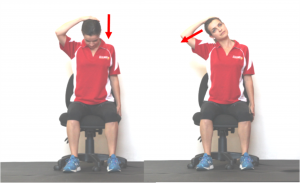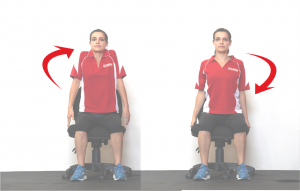Problem: Pain and stiffness in the neck and shoulders from hunching over your computer
Solution: Change the height of your computer screen, move more including stretching the tight muscles
A common problem when working from home, especially if people don’t have a professional desk and computer set up. Someone who is used to a full work station at the office is probably working from just a single laptop at home, and often their posture is all wrong. Desk ergonomics play a very important role in correct posture when people are at the computer, incorrect posture can cause pain and misalignment.
Some of the main points include:
- Screen should be set at eye level so head is neutral, eyes forward.
- Table/desk should be at elbow height so shoulders are relaxed and elbows are at 90 degrees.
- Backrest should support the natural curve of the lower back
- Thighs should be parallel to the floor and bent to about 90 degrees
- Feet should be flat on the floor or fully supported
- Room under the desk should be clear for legs and feet to move
Being stuck at home on a laptop without a full office set up means people are having to look down at their screen and tilt their neck forwards. Desk or table height may be too heigh or too low causing shoulders to elevate/shrug up or roll forwards and round. These positions all leave people with stiff and sore neck and shoulder muscles. Long-term this can lead to disc degeneration.
A couple of simple solutions can help
- Position your screen a little bit higher by placing it on a stack of books or copy paper
- If you are working on a lap top get a separate keyboard to allow you to move the screen higher but keep the keyboard lower.
- Get up and move around more, even if it’s just stand up, have a quick stretch and sit back down. Try to get up at least once an hour.
- Include stretches that reverse the positioning of being hunched forward target the tight muscles in the neck and shoulders – these include the upper trapezius, SCM, pecs and deltoids.
| Seated chest stretch
Sitting comfortably, simply open your arms up as wide as you can and lean back into your chairs back rest to allow your chest and shoulder to open up. Hold for 30 seconds.
|
 |
| Wall chest stretch
Stand up next to a wall and place your hand, palm down, against the wall beside/behind you. Slowly turn your body away from the wall until your feel a stretch in your chest/shoulder. Hold for 30 seconds and repeat on the other side. *If you find this stretch is uncomfortable at your elbow or hits too much biceps, you can modify the stretch with a bent elbow and place the forearm against the wall. |
 |
| Seated neck stretch
Sitting comfortably, tuck your chin into your chest and put a small amount of gentle pressure on the back of your head to stretch the back of your neck. Hold for 30 seconds. Repeat to the side by tilting your ear to your shoulder to stretch the side of the neck (upper traps and SCM muscles).
|
 |
| Shoulder rolls
Sitting comfortably, shrug your shoulders up towards your ears, then pull them down and back to open up your chest, repeat circles 10 times. |
 |

